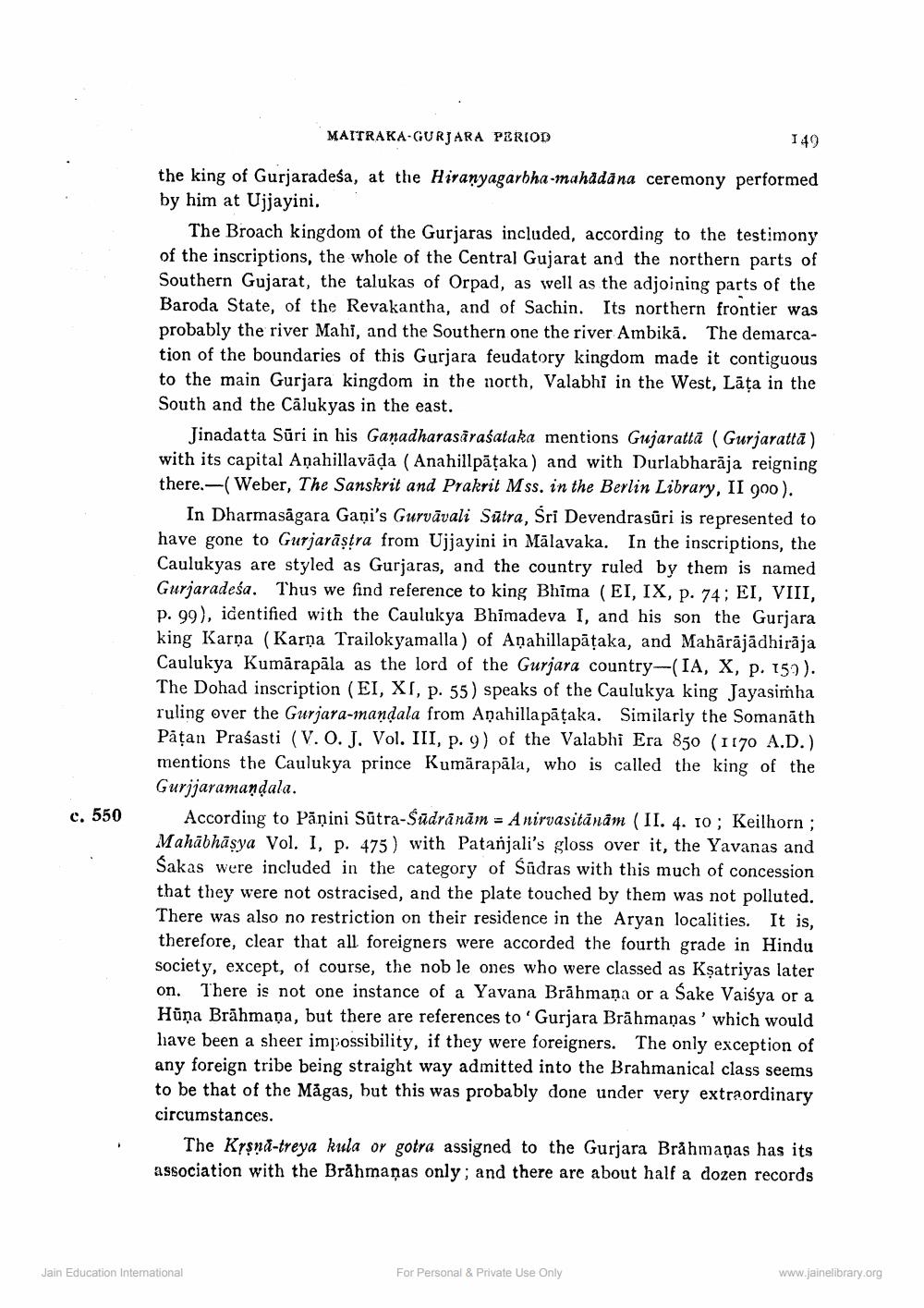________________
MAITRAKA-GURJARA PERIOD
149
the king of Gurjaradeśa, at the Hiranyagarbha-mahädäna ceremony performed by him at Ujjayini.
The Broach kingdom of the Gurjaras included, according to the testimony of the inscriptions, the whole of the Central Gujarat and the northern parts of Southern Gujarat, the talukas of Orpad, as well as the adjoining parts of the Baroda State, of the Revakantha, and of Sachin. Its northern frontier was probably the river Mahi, and the Southern one the river Ambikā. The demarcation of the boundaries of this Gurjara feudatory kingdom made it contiguous to the main Gurjara kingdom in the north, Valabhi in the West, Läta in the South and the Cālukyas in the east.
Jinadatta Sūri in his Ganadharasaraśataka mentions Gujaratta (Gurjaratta ) with its capital Anahillavāda (Anahillpāțaka) and with Durlabharāja reigning there.—(Weber, The Sanskrit and Prakrit Mss. in the Berlin Library, II 900).
In Dharmasagara Gani's Gurvāvali Sūtra, Sri Devendrasűri is represented to have gone to Gurjarāștra from Ujjayini in Mālavaka. In the inscriptions, the Caulukyas are styled as Gurjaras, and the country ruled by them is named Gurjaradeśa. Thus we find reference to king Bhima (EI, IX, p. 74; EI, VIII, P. 99), identified with the Caulukya Bhimadeva I, and his son the Gurjara king Karna (Karna Trailokyamalla) of Anahillapāțaka, and Mahārājādhirāja Caulukya Kumārapāla as the lord of the Gurjara country--(IA, X, p. 159). The Dohad inscription (EI, XI, p. 55) speaks of the Caulukya king Jayasimha ruling over the Gurjara-mandala from Apahilla pāțaka. Similarly the Somanāth Patan Prasasti (V.O. J. Vol. III, p. 9) of the Valabhi Era 850 (1170 A.D.). mentions the Caulukya prince Kumārapāla, who is called the king of the Gurjjaramandala.
According to Pāṇini Sūtra-Śūdrānām = Anirvasitānām (II. 4. 10; Keilhorn; Mahābhāsya Vol. I, p. 475) with Patanjali's gloss over it, the Yavanas and Sakas were included in the category of Sūdras with this much of concession that they were not ostracised, and the plate touched by them was not polluted. There was also no restriction on their residence in the Aryan localities. It is, therefore, clear that all foreigners were accorded the fourth grade in Hindu society, except, of course, the nob le ones who were classed as Ksatriyas later on. There is not one instance of a Yavana Brāhmaṇa or a Śake Vaisya or a Hüņa Brāhmaṇa, but there are references to 'Gurjara Brāhmaṇas' which would have been a sheer impossibility, if they were foreigners. The only exception of any foreign tribe being straight way admitted into the Brahmanical class seems to be that of the Mågas, but this was probably done under very extraordinary circumstances.
The Kysna-treya kula or gotra assigned to the Gurjara Bråhmaṇas has its association with the Brāhmaṇas only; and there are about half a dozen records
c. 550
Jain Education Intemational
For Personal & Private Use Only
www.jainelibrary.org




